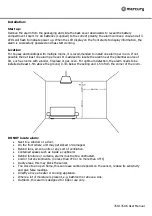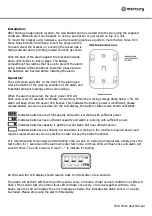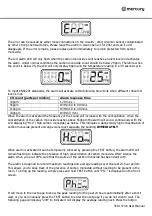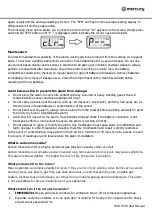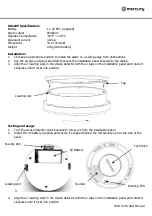
350.137UK User Manual
again or wait and the average reading will show. The “PPM” will flash on the average reading display to
differentiate it from the peak reading.
The following menu option allows you to clear the record. When “clr” appears on the screen, simply press
and hold the TEST button until “P
--
” is displayed which indicates the record has been deleted.
Maintenance:
In order to maintain the sensitivity of the alarm, dust needs to be removed from the surface on a regular
basis. To dust use a slightly damp cloth, a brush or brush attachment of a vacuum cleaner. Do not use
any solvent based cleaner as the sensor is sensitive to all active gas including chemical cleaners. Always
perform a manual test after cleaning to ensure the alarm is working normally. Also, the battery
compartment needs to be checked on regular basis for signs of battery acid leakage. Remove batteries
immediately if any signs of leakage occur. Clean the compartment with a clean tissue/cloth before
replacing with new batteries.
Avoid below action to prevent the alarm from damage:
Do not allow the alarm to come into contact with any coloured or heavy smelling gas as this will
contaminate the sensor and false readings will occur.
Do not spray aerosols near the alarm, such as: air freshener, insect killer, perfume, hair spray etc. as
this will result in false readings or contamination of the sensor.
Do not paint over the alarm, always remove alarm from the bracket before painting and wait for paint
to be fully dry before reinstalling the alarm.
Avoid shock or impact on the alarm, if accidentally dropped check if the battery connection is still
intact and perform a manual test to ensure the alarm is working correctly.
Do not attempt to repair or modify the alarm. Any modification may cause alarm to malfunction and
fail to operate in a life-threatening situation, therefore modification and repair is strictly restricted.
In the event of contamination, leave alarm in fresh air for a minimum of 30 mins to up to a week to see if
it recovers. If readings are still false replace the alarm immediately.
What is carbon monoxide?
Carbon monoxide (CO) is a highly poisonous gas that has no taste, colour or smell.
Carbon monoxide is a cumulative poison meaning long-term exposure to low levels may cause symptoms.
This alarm is time-weighted
–
the higher the level of CO, the sooner it will alarm.
What produces CO in the home?
Many appliances can produce deadly CO levels if they are not in fully working order. Items such as wood
burning stoves, gas boilers, gas fires, gas hobs and ovens, oil and coal burning units, portable gas
heaters, blocked flues and chimneys, car fumes from an integral garage and even barbeques. This alarm
is not a substitute for proper maintenance of your appliances.
What should I do if the CO alarm sounds?
1.
IMMEDIATELY
open all doors & windows for ventilation & turn off all combustion appliances.
2.
Evacuate everyone outdoors or to an open door or window for fresh air. Do a head count to check
all persons are accounted for.


